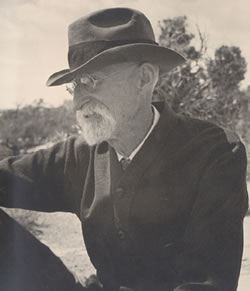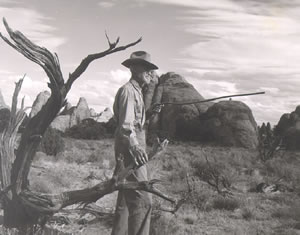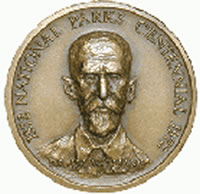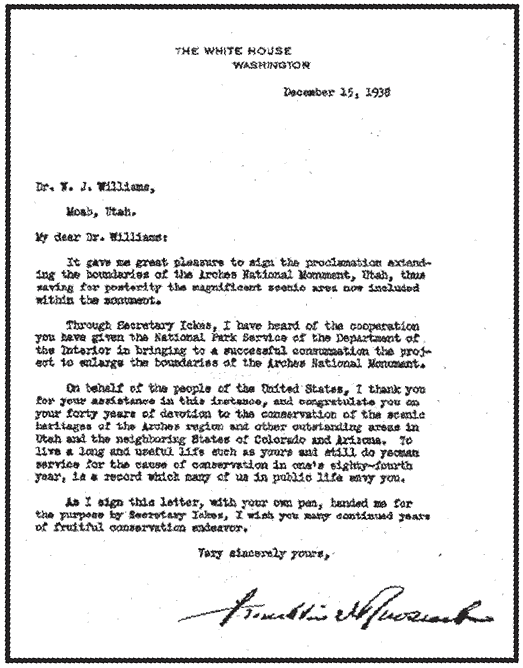Illustrious
Life of J.W. Williams,
Moab’s First Doctor,
spanned over a Century
by Jeff Richards
 Forty-eight
years ago, on Aug. 13, 1956, Moab saw the passing of
Dr. J.W. Williams, one of the area’s most illustrious
and well-respected characters. He was 103 years old.
Forty-eight
years ago, on Aug. 13, 1956, Moab saw the passing of
Dr. J.W. Williams, one of the area’s most illustrious
and well-respected characters. He was 103 years old.
Dr. Williams was instrumental in not only laying the
foundation of the community itself, but also in taking
care of the health of its residents. He was also an
avid promoter of tourism to the Southeastern Utah area,
and has often been known as “The Father of Arches
National Monument.”
Born in a log cabin in Missouri on Aug. 3, 1853, Dr.
Williams crossed the plains of Kansas at age 20 and
settled in Colorado in 1874. After herding cattle for
several years and serving as a druggist in Hugo, Colo.
for over a decade, he later went to the Denver area
to attend medical school. Then, after graduating from
Gross Medical School, Williams practiced medicine in
Ordway, Colo. for a time before accepting the invitation
of Grand County commissioners to move to Moab and become
the community’s physician for a guaranteed salary of $150 per
year.
Dr. Williams first arrived in Moab via stagecoach either in late November
of 1896 or mid-January of 1897, and set up his medical practice immediately.
He made house calls throughout Grand and San Juan Counties, sometimes
traveling by horse and buggy and other times simply on horseback, his
saddlebags packed with bandages, remedies, and medical supplies. He
would regularly visit sheepherders camps, mining towns, and cowboys
on the range, and was known for his rugged outdoor skills as much as
he was for his medical prowess.
Dr. Williams married Lavina Larson in 1900, and the couple had five
children together. Their youngest son Mitch Williams remains a resident
of Moab to this day.
 Dr.
Williams was also instrumental in helping the town of Moab (population
300) become officially incorporated in 1902. The much-anticipated event
occurred during a landmark two-day Grand County Board of Commissioners
meeting held Dec. 29-30, 1902. Williams was one of five councilmen
who were appointed to serve as the trustees for the fledgling city
until the first town election could be held. The other four founders
were V.P. Martin (a local merchant), Henry Grimm (a blacksmith), D.A.
Johnson (a local church bishop), and Harry Green, the board’s
president who had spearheaded the incorporation petition.
Dr.
Williams was also instrumental in helping the town of Moab (population
300) become officially incorporated in 1902. The much-anticipated event
occurred during a landmark two-day Grand County Board of Commissioners
meeting held Dec. 29-30, 1902. Williams was one of five councilmen
who were appointed to serve as the trustees for the fledgling city
until the first town election could be held. The other four founders
were V.P. Martin (a local merchant), Henry Grimm (a blacksmith), D.A.
Johnson (a local church bishop), and Harry Green, the board’s
president who had spearheaded the incorporation petition.
The bearded, bespectacled Dr. Williams practiced medicine full-time
until his retirement in 1919 at age 66. The year before, Moab had endured
the outbreak of the so-called Spanish Flu, which killed tens of millions
worldwide. In Moab, the influenza epidemic was so bad that Jasper Meador
reportedly had to leave his store unattended so that he could help
Dr. Williams care for the many town residents who were sick. Although
Meador’s store was reportedly left open for customers to ring
up their own purchases, not a penny was stolen.
For decades after his retirement, Dr. Williams continued to provide
limited medical care for friends and close acquaintances, and eventually
was believed to be the oldest licensed physician in the United States.
One thing that retirement afforded Dr. Williams was the chance to devote
more time to other pursuits, including the promotion of tourism in
the area and the eventual creation and expansion of Arches National
Monument (later Arches National Park). New visitors to town (especially
dignitaries) were often accompanied by Dr. Williams to sightsee in
the surrounding countryside.
One such first-time visitor was Dr. Larry Gould, who arrived in Moab
in 1921 to do a geological survey of the La Sal Mountains. Williams
(who never learned to drive a vehicle) reportedly took Gould to the
area in Arches known as the Windows.
 Three
years later, in 1924, Gould returned to spend the summer in Moab. Several
months later, he began a letter-writing campaign for official protection
of the area by the U.S. National Park Service, enlisting the help of
Sen. Reed Smoot of Utah.
Three
years later, in 1924, Gould returned to spend the summer in Moab. Several
months later, he began a letter-writing campaign for official protection
of the area by the U.S. National Park Service, enlisting the help of
Sen. Reed Smoot of Utah.
In 1929, while Gould was in Antarctica as a member of Admiral Byrd’s
South Pole expedition, the 4,520-acre Arches National Monument was
officially created. At that time, the monument included the Windows
and Devil’s Garden areas but not Klondike Bluffs, the “Schoolmarm’s
Bloomers” (Delicate Arch), nor Courthouse Towers.
Dr. Williams wasn’t satisfied with the size of the new monument,
and, with the help of the Moab Lions Club in the early 1930s, embarked
on a tireless campaign to expand its boundaries. Their efforts were
rewarded in 1938 when Pres. Franklin D. Roosevelt signed a proclamation
expanding the monument to 33,930 acres.
In 1941, construction briefly began on an access road into the park,
following the route that Dr. Williams himself had recommended (it had
been his own preferred path when traveling by horseback or on foot).
However, World War II caused the road construction to be put on hold
for several years. It wasn’t until after 1953 (when Williams
turned 100) that construction began in earnest on the access road.
Three years later, in early 1956, Doc Williams, then 102, asked Arches
Superintendent Bates Wilson to drive him into Arches, quipping that
he needed to make sure that the road was being put in the right place.
That rough Jeep trip to Balanced Rock and back proved to be Williams’ last
foray into Arches National Monument. He died just a few months later,
10 days after his 103rd birthday.
In 1958, the road into Arches was finally finished, and Dr. Williams’ widow
Lavina performed the ribbon-cutting honors. More than a dozen years
later, in 1971, Arches finally became a national park, its boundaries
expanded to 73,379 acres.
In the decades after Dr. Williams’ long life came to a close,
his legacy has continued, and many of Moab’s older residents
today still fondly remember the illustrious doctor. As Robert Sundwall
wrote on the occasion of Williams’ 100th birthday, “As
much of the geological history of the world is found in the rocks of
the Arches, so is the human history of the desert oasis of Moab found
in this venerable person.”
